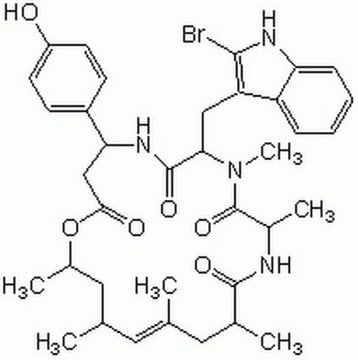428021
Latrunculin A
from Latrunculia magnifica, ≥95% (HPLC), solid, actin polymerization inhibitor, Calbiochem
Synonym(s):
Latrunculin A, Latrunculia magnifica
About This Item
Recommended Products
product name
Latrunculin A, Latrunculia magnifica, Latrunculin A, CAS 76343-93-6, is a cell-permeable marine toxin that disrupts microfilament organization in cultured cells by the formation of a 1:1 complex with monomeric G-actin (KD = 200 nM).
Quality Level
Assay
≥95% (HPLC)
form
solid
manufacturer/tradename
Calbiochem®
storage condition
OK to freeze
protect from light
color
white
solubility
DMSO: 25 mg/mL
shipped in
ambient
storage temp.
−20°C
InChI
1S/C22H31NO5S/c1-15-7-5-3-4-6-8-16(2)11-20(24)27-18-12-17(10-9-15)28-22(26,13-18)19-14-29-21(25)23-19/h3-5,7,11,15,17-19,26H,6,8-10,12-14H2,1-2H3,(H,23,25)/b4-3+,7-5-,16-11-/t15-,17-,18-,19+,22-/m1/s1
InChI key
DDVBPZROPPMBLW-IZGXTMSKSA-N
General description
Biochem/physiol Actions
G-actin
Packaging
Warning
Reconstitution
Other Notes
Spector, I., et al. 1989. Cell Motil. Cytoskeleton 13, 127.
Coue, M., et al. 1987. FEBS Lett. 213, 316.
Schatten, G., et al. 1986. Exp. Cell Res. 166, 191.
Spector, I., et al. 1983. Science 219, 493.
Legal Information
Storage Class Code
11 - Combustible Solids
WGK
WGK 3
Flash Point(F)
Not applicable
Flash Point(C)
Not applicable
Certificates of Analysis (COA)
Search for Certificates of Analysis (COA) by entering the products Lot/Batch Number. Lot and Batch Numbers can be found on a product’s label following the words ‘Lot’ or ‘Batch’.
Already Own This Product?
Find documentation for the products that you have recently purchased in the Document Library.
Customers Also Viewed
Our team of scientists has experience in all areas of research including Life Science, Material Science, Chemical Synthesis, Chromatography, Analytical and many others.
Contact Technical Service
















